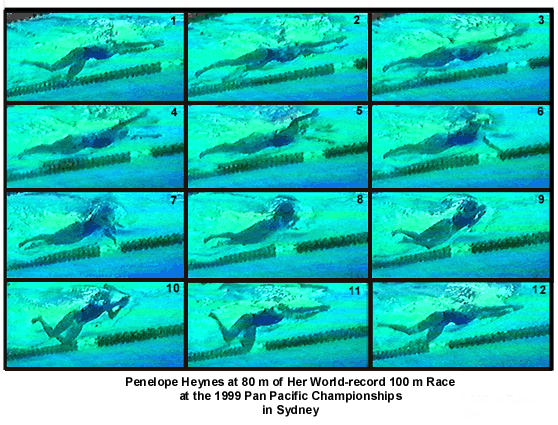
PENELOPE HEYNES AT 80 m OF HER WORLD-RECORD 100 m RACE AT THE 1999 PAN PACIFIC CHAMPIONSHIPS IN SYDNEY
PENELOPE HEYNES AT 80 m OF HER WORLD-RECORD 100 m RACE AT THE 1999 PAN PACIFIC CHAMPIONSHIPS IN SYDNEY
Each frame is .1 seconds apart. The reader should review the other detailed analyses of Penny Heynes' stroke included in this section of the Swimming Science Journal. The time for this 100-m heat race was 1:06.52, a new world record. Her semi-final and final times were slower.
Notable Features
The discussion of Penny Heynes' stroke in this analysis will be presented in general terms, rather than a frame-by-frame analysis. Reviewing other analyses of her stroke will provide details of each action phase.

One of the important factors associated with breaststroke swimming is the breathing action. Particularly with female swimmers, it is not uncommon to see virtually the head, whole torso, and upper arms lifted at the end of the inward arm movement. That action produces a very large demand for a vertical force and would also contribute to a detrimental dropping of the hips and thighs. The sequence below shows Penny Heynes' head and shoulder action. The first frame is when the head is at its highest point above the water surface. From there the shoulders and head are driven forward and down in unison. There is only a small initial alteration in the orientation of the neck in relation to both the head and shoulders. This movement is also reminiscent of Mike Barrowman's breathing action. It minimizes vertical and rotary movements in the total swimmer and is unlike an excessive lifting movement. It epitomizes "breathing low."
This action appears to be different to that displayed by Penny Heynes at the Atlanta Olympic Games. There, she "ducked" her head on returning it after breathing. Her head moved to a much greater extent than her shoulders. That produced a slight rocker action, which is not exhibited in this stroke. One could propose that the shortest, lowest breathing action that employs a unified head and torso return to streamline is a desirable action worthy of emulation. In this case, it could also be a factor that has contributed to Penny Heynes' improvements in performance.

Return to Table of Contents for this section.
